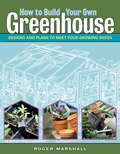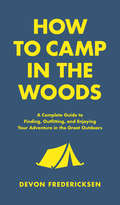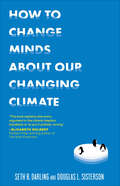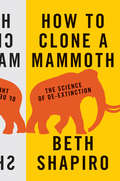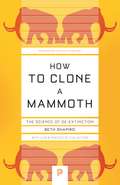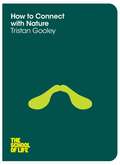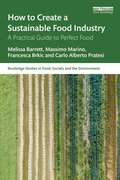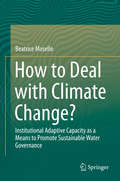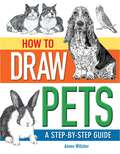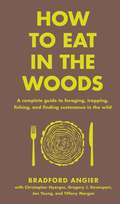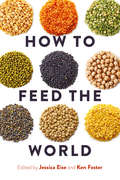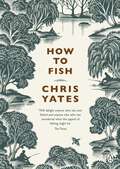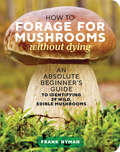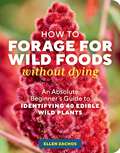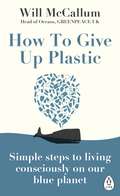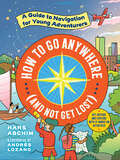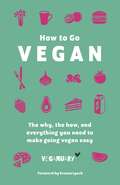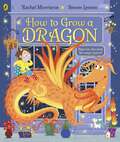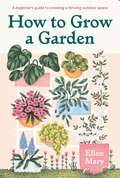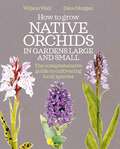- Table View
- List View
How to Build Your Own Greenhouse: Designs and Plans to Meet Your Growing Needs
by Roger MarshallUnlock new growing opportunities and increase your property value with an outdoor conservatory. In this illustrated guide, Roger Marshall shows you how to build our own greenhouse using simple, easy-to-follow techniques. Covering everything from selecting a site to glazing glass, Marshall includes tips on laying a foundation, construction materials, ventilation, and much more. Whether your goal is to stretch the growing season or create a lush space for a year-round hot tub, you can build the greenhouse of your dreams.
How to Camp in the Woods: A Complete Guide to Finding, Outfitting, and Enjoying Your Adventure in the Great Outdoors (In The Woods)
by Devon FredericksenImmerse yourself in the natural world with How to Camp in the Woods, the book StarTribune says "does all but set up the tent."Perfect for everyone from novices to boondockers, How to Camp in the Woods compiles contemporary and classic wisdom, practical tips, and illustrated DIY advice on every aspect of equipping, packing, setting up camp, cooking, and improvising no matter where you are in the great outdoors. How to Camp in the Woods will teach readers: Camping and survival basics including fire building, essential knots, site finding, wilderness first aid/CPR, map/compass reading, and camping off the grid. Essential gear, packing light, recommendations for DIY if you've left something behind, and how to keep everything relatively clean. Guides to camping comfortably in all seasons and weather, as well as tips and etiquette for camping around the world, including with pets and kids. Tips for enhancing the experience, including recipes for easy and inexpensive meals from 25 base ingredients, stargazing essentials, fireside games and songs, bird-watching, and the perfect campfire reading list.
How to Camp in the Woods: A Complete Guide to Finding, Outfitting, and Enjoying Your Adventure in the Great Outdoors (In the Woods)
by Devon FredericksenImmerse yourself in the natural world with How to Camp in the Woods, the book StarTribune says "does all but set up the tent."Perfect for everyone from novices to boondockers, How to Camp in the Woods compiles contemporary and classic wisdom, practical tips, and illustrated DIY advice on every aspect of equipping, packing, setting up camp, cooking, and improvising no matter where you are in the great outdoors. How to Camp in the Woods will teach readers:Camping and survival basics including fire building, essential knots, site finding, wilderness first aid/CPR, map/compass reading, and camping off the grid. Essential gear, packing light, recommendations for DIY if you've left something behind, and how to keep everything relatively clean. Guides to camping comfortably in all seasons and weather, as well as tips and etiquette for camping around the world, including with pets and kids. Tips for enhancing the experience, including recipes for easy and inexpensive meals from 25 base ingredients, stargazing essentials, fireside games and songs, bird-watching, and the perfect campfire reading list.
How to Change Minds About Our Changing Climate
by Seth B. Darling Douglas L. SistersonThe book to spark action on the defining challenge of our time In our post-truth world, there&’s only one place to turn to if we want to live in reality: science. And the research on climate change is clear: It&’s real, it threatens us all, and human activity is the primary cause. This essential handbook dismantles all the most pernicious misunderstandings spread by deniers and replaces them with the truth. Faced with an imperiled planet that we must urgently work to save, we don&’t have time for anything else.
How to Clone a Mammoth: The Science of De-Extinction
by Beth ShapiroCould extinct species, like mammoths and passenger pigeons, be brought back to life? The science says yes. In How to Clone a Mammoth, Beth Shapiro, evolutionary biologist and pioneer in "ancient DNA" research, walks readers through the astonishing and controversial process of de-extinction. From deciding which species should be restored, to sequencing their genomes, to anticipating how revived populations might be overseen in the wild, Shapiro vividly explores the extraordinary cutting-edge science that is being used--today--to resurrect the past. Journeying to far-flung Siberian locales in search of ice age bones and delving into her own research--as well as those of fellow experts such as Svante Paabo, George Church, and Craig Venter--Shapiro considers de-extinction's practical benefits and ethical challenges. Would de-extinction change the way we live? Is this really cloning? What are the costs and risks? And what is the ultimate goal? Using DNA collected from remains as a genetic blueprint, scientists aim to engineer extinct traits--traits that evolved by natural selection over thousands of years--into living organisms. But rather than viewing de-extinction as a way to restore one particular species, Shapiro argues that the overarching goal should be the revitalization and stabilization of contemporary ecosystems. For example, elephants with genes modified to express mammoth traits could expand into the Arctic, re-establishing lost productivity to the tundra ecosystem. Looking at the very real and compelling science behind an idea once seen as science fiction, How to Clone a Mammoth demonstrates how de-extinction will redefine conservation's future.
How to Clone a Mammoth: The Science of De-Extinction
by Beth ShapiroCould extinct species, like mammoths and passenger pigeons, be brought back to life? The science says yes. In How to Clone a Mammoth, Beth Shapiro, evolutionary biologist and pioneer in "ancient DNA" research, walks readers through the astonishing and controversial process of de-extinction. From deciding which species should be restored, to sequencing their genomes, to anticipating how revived populations might be overseen in the wild, Shapiro vividly explores the extraordinary cutting-edge science that is being used--today--to resurrect the past. Journeying to far-flung Siberian locales in search of ice age bones and delving into her own research--as well as those of fellow experts such as Svante Paabo, George Church, and Craig Venter--Shapiro considers de-extinction's practical benefits and ethical challenges. Would de-extinction change the way we live? Is this really cloning? What are the costs and risks? And what is the ultimate goal? Using DNA collected from remains as a genetic blueprint, scientists aim to engineer extinct traits--traits that evolved by natural selection over thousands of years--into living organisms. But rather than viewing de-extinction as a way to restore one particular species, Shapiro argues that the overarching goal should be the revitalization and stabilization of contemporary ecosystems. For example, elephants with genes modified to express mammoth traits could expand into the Arctic, re-establishing lost productivity to the tundra ecosystem. Looking at the very real and compelling science behind an idea once seen as science fiction, How to Clone a Mammoth demonstrates how de-extinction will redefine conservation's future.
How to Clone a Mammoth: The Science of De-Extinction (Princeton Science Library #108)
by Beth ShapiroAn insider's view on bringing extinct species back to lifeCould extinct species, like mammoths and passenger pigeons, be brought back to life? In How to Clone a Mammoth, Beth Shapiro, an evolutionary biologist and pioneer in ancient DNA research, addresses this intriguing question by walking readers through the astonishing and controversial process of de-extinction. From deciding which species should be restored to anticipating how revived populations might be overseen in the wild, Shapiro vividly explores the extraordinary cutting-edge science that is being used to resurrect the past. Considering de-extinction's practical benefits and ethical challenges, Shapiro argues that the overarching goal should be the revitalization and stabilization of contemporary ecosystems. Looking at the very real and compelling science behind an idea once seen as science fiction, How to Clone a Mammoth demonstrates how de-extinction will redefine conservation's future.
How to Clone a Mammoth: The Science of De-Extinction (Princeton Science Library #108)
by Beth ShapiroAn insider's view on bringing extinct species back to lifeCould extinct species, like mammoths and passenger pigeons, be brought back to life? In How to Clone a Mammoth, Beth Shapiro, an evolutionary biologist and pioneer in ancient DNA research, addresses this intriguing question by walking readers through the astonishing and controversial process of de-extinction. From deciding which species should be restored to anticipating how revived populations might be overseen in the wild, Shapiro vividly explores the extraordinary cutting-edge science that is being used to resurrect the past. Considering de-extinction's practical benefits and ethical challenges, Shapiro argues that the overarching goal should be the revitalization and stabilization of contemporary ecosystems. Looking at the very real and compelling science behind an idea once seen as science fiction, How to Clone a Mammoth demonstrates how de-extinction will redefine conservation's future.
How to Connect with Nature (The School of Life #2)
by Tristan Gooley The School of LifeA deep knowledge of our natural environment is no longer a vital part of everyday survival, certainly for those of us living in cities and working in weatherproof offices. Unless we have an inherent love of the great outdoors, do we really need to connect with nature? Bestselling author Tristan Gooley believes that real connection, no matter how small, can enrich us as individuals, allowing us to see every living thing in its own intricate network. Offering a host of techniques, he helps us awaken our senses and deepen our understanding of nature's cycles, conflicts and relationships. By cultivating the right mindset we can gain a better appreciation of the world, both indoors and outdoors. One in the new series of books from The School of Life, launched January 2014: How to Age by Anne Karpf How to Develop Emotional Health by Oliver James How to Be Alone by Sara Maitland How to Deal with Adversity by Christopher Hamilton How to Think About Exercise by Damon Young How to Connect with Nature by Tristan Gooley
How to Create a Sustainable Food Industry: A Practical Guide to Perfect Food (Routledge Studies in Food, Society and the Environment)
by Melissa Barrett Massimo Marino Francesca Brkic Carlo Alberto PratesiThis book presents a practical guide to help businesses navigate the complex topics of sustainability in the food industry. The book takes you on a journey along the food value chain, from farm to fork, exploring key opportunities to increase positive impacts and circularity at each step of the journey. Written by a team of authors with decades of experience in the food industry and academia, it provides guidance on how to analyse sustainability across the value chain and life cycle of a food product and how to design, implement and communicate strategies to customers. Furthermore, the book shows that there are not always straightforward solutions, but rather choices and trade-offs that require an understanding of what is best suited to the product, customers and business in question. It demystifies a variety of topics, such as local sourcing, regenerative agriculture, plant-based protein and the environmental impact of meat production, and draws on a wide range of case studies from across the globe, to provide concrete, real-world examples. While a perfect food system may not exist, informed decisions can go a long way to reshape and transform the food industry as we know it. This book will be of great interest to professionals working in the food and agriculture industries, as well as students and scholars of sustainable food systems and sustainable business.
How to Create a Sustainable Food Industry: A Practical Guide to Perfect Food (Routledge Studies in Food, Society and the Environment)
by Melissa Barrett Massimo Marino Francesca Brkic Carlo Alberto PratesiThis book presents a practical guide to help businesses navigate the complex topics of sustainability in the food industry. The book takes you on a journey along the food value chain, from farm to fork, exploring key opportunities to increase positive impacts and circularity at each step of the journey. Written by a team of authors with decades of experience in the food industry and academia, it provides guidance on how to analyse sustainability across the value chain and life cycle of a food product and how to design, implement and communicate strategies to customers. Furthermore, the book shows that there are not always straightforward solutions, but rather choices and trade-offs that require an understanding of what is best suited to the product, customers and business in question. It demystifies a variety of topics, such as local sourcing, regenerative agriculture, plant-based protein and the environmental impact of meat production, and draws on a wide range of case studies from across the globe, to provide concrete, real-world examples. While a perfect food system may not exist, informed decisions can go a long way to reshape and transform the food industry as we know it. This book will be of great interest to professionals working in the food and agriculture industries, as well as students and scholars of sustainable food systems and sustainable business.
How to Deal with Climate Change?: Institutional Adaptive Capacity as a Means to Promote Sustainable Water Governance
by Beatrice MoselloAs the evidence for human-induced climate change becomes more obvious, so too does the realisation that it will harshly impact on the natural environment as well as on socio-economic systems. Addressing the unpredictability of multiple sources of global change makes the capacity of governance systems to deal with uncertainty and surprise essential. However, how all these complex processes act in concert and under which conditions they lead to the sustainable governance of environmental resources are questions that have remained relatively unanswered. This book aims at addressing this fundamental gap, using as case examples the basins of the Po River in Northern Italy and the Syr Darya River in Kyrgyzstan. The opening chapter addresses the challenges of governing water in times of climate and other changes. Chapter Two reviews water governance through history and science. The third chapter outlines a conceptual framework for studying institutional adaptive capacity. The next two chapters offer detailed case studies of the Po and Syr Darya rivers, followed by a chapter-length analysis and comparison of adaptive water resources management in the two regions. The discussion includes a description of resistant, reactive and proactive institutions and puts forward ideas on how water governance regimes can transition from resistant to proactive. The final chapter takes a high-level view of lessons learned and how to transform these into policy recommendations and offers a perspective on embracing uncertainty and meeting future challenges.
How To Draw Pets: A Step-by-Step Guide
by Aimee WillsherPets are the most endearing of subjects. Capture the fuzzy feathers of a ducking or a cat stalking their prey in this beautifully illustrated, user-friendly manual. Award-winning artist Aimee Willsher shows you how to capture the essence of the animals you love using a range of drawing media. Including:• More than 20 step-by-step projects• Exercises showing how to master the primary shapes of popular pets• Tutorials on drawing your pet from life and from photographs• Demonstrations of a range of compositionsWhether you're a complete novice or want to take your pet portraits to the next level, How to Draw Pets will provide a firm grounding from which you can gain the confidence to develop your own style.
How to Eat in the Woods: A Complete Guide to Foraging, Trapping, Fishing, and Finding Sustenance in the Wild (In the Woods)
by Bradford AngierA comprehensive, practical, and reliable guide to finding food in the woods and living off the land, by respected wilderness survivalists. With text by wilderness survivalists, the information in How to Eat in the Woods is tried, trusted, and true. One of the most complete books written on the subject, this portable guide includes essential information on how to track, trap, kill, and prepare various types of animals; select bait, land fish, and clean and cook the catch; recognize edible plants, fruits, berries, and nuts; locate bird eggs; catch edible insects; and find potable water. Also included is information on building a fire and preparing food without utensils.
How to Eat in the Woods: A Complete Guide to Foraging, Trapping, Fishing, and Finding Sustenance in the Wild (In the Woods)
by Bradford AngierA comprehensive, practical, and reliable guide to finding food in the woods and living off the land, by respected wilderness survivalists. With text by wilderness survivalists, the information in How to Eat in the Woods is tried, trusted, and true. One of the most complete books written on the subject, this portable guide includes essential information on how to track, trap, kill, and prepare various types of animals; select bait, land fish, and clean and cook the catch; recognize edible plants, fruits, berries, and nuts; locate bird eggs; catch edible insects; and find potable water. Also included is information on building a fire and preparing food without utensils.
How to Feed the World
by Jessica Eise and Kenneth Alan FosterBy 2050, we will have ten billion mouths to feed in a world profoundly altered by environmental change. How can we meet this challenge? In How to Feed the World, a diverse group of experts from Purdue University break down this crucial question by tackling big issues one-by-one. Covering population, water, land, climate change, technology, food systems, trade, food waste and loss, health, social buy-in, communication, and, lastly, the ultimate challenge of achieving equal access to food, the book reveals a complex web of factors that must be addressed in order to reach global food security. How to Feed the World unites contributors from different perspectives and academic disciplines, ranging from agronomy and hydrology to agricultural economy and communication. Hailing from Germany, the Philippines, the U.S., Ecuador, and beyond, the contributors weave their own life experiences into their chapters, connecting global issues to our tangible, day-to-day existence. Across every chapter, a similar theme emerges: these are not simple problems, yet we can overcome them. Doing so will require cooperation between farmers, scientists, policy makers, consumers, and many others. The resulting collection is an accessible but wide-ranging look at the modern food system. Readers will not only get a solid grounding in key issues, but be challenged to investigate further and contribute to the paramount effort to feed the world.
How to Fish
by Christopher YatesSitting on a riverbank, with rod and line, must count as one of the most relaxing and enjoyable – yet occasionally frustrating – experiences known to man.Chris Yates discovered the joys of fishing early in life and was quickly hooked by its pleasures. Many years later, he is still content to sit, day after day, observing the quirks of different fish and losing track of time. For him, fishing is much more than just a question of technique; sometimes it’s about listening to nothing but your instincts, and at other times it’s about enjoying the perfect cup of tea. And it’s always about not knowing how the day is going to unfold . . .There’s no better guide for the uninitiated – and no better companion for those already familiar with the satisfactions of fishing – than Chris Yates. And immersing yourself in How To Fish is almost as delightful an activity as fishing itself.
How to Forage for Mushrooms without Dying: An Absolute Beginner's Guide to Identifying 29 Wild, Edible Mushrooms
by Frank HymanWith the surging interest in foraging for mushrooms, those new to the art need a reliable guide to distinguishing the safe fungi from the toxic. But for beginner foragers who just want to answer the question &“Can I eat it?&”, most of the books on the subject are dry, dense, and written by mycologists for other mycologists. Frank Hyman to the rescue! How to Forage for Mushrooms without Dying is the book for anyone who walks in the woods and would like to learn how to identify just the 29 edible mushrooms they&’re likely to come across. In it, Hyman offers his expert mushroom foraging advice, distilling down the most important information for the reader in colorful, folksy language that&’s easy to remember when in the field. Want an easy way to determine if a mushroom is a delicious morel or a toxic false morel? Slice it in half – &“if it&’s hollow, you can swallow,&” Hyman says. With Frank Hyman&’s expert advice and easy-to-follow guidelines, readers will be confident in identifying which mushrooms they can safely eat and which ones they should definitely avoid.
How to Forage for Wild Foods without Dying: An Absolute Beginner's Guide to Identifying 40 Edible Wild Plants
by Ellen ZachosThis on-the-go guide is perfect for new foragers eager to learn about the edible plants they're most likely to find, no matter what region they're in, and provides photos and easy-to-follow identification and use guidelines for the 40 most common—and most delicious—wild plants.How to Forage for Wild Foods without Dying is a book for anyone who likes to go on nature walks and would like to learn about the edible plants they&’re most likely to come across—no matter what region they&’re in. Author Ellen Zachos shares her considerable expertise, acquired over decades of foraging in every part of North America. She offers clear, concise descriptions of edible wild plants, in addition to any potential lookalikes, as well as critical information about proper harvesting, processing, and cooking. Zachos has curated the plant selection to include only the 40 most common, most delicious edible plants, ranging from black walnuts and juniper berries to elderflowers, burdock, fiddlehead ferns, lambsquarter, wild garlic, sunchokes, and many more. With Zachos&’s expert advice and easy-to-follow guidelines, readers will be confident in identifying which plants they can safely eat and which ones they should definitely avoid. Easy instructions for preparation and eating for maximum enjoyment are included.
How to Give Up Plastic: A Guide to Changing the World, One Plastic Bottle at a Time. From the Head of Oceans at Greenpeace and spokesperson for their anti-plastic campaign
by Will McCallum'We have a responsibility, every one of us' David Attenborough Around 12.7 million tonnes of plastic are entering the ocean every year, killing over 1 million seabirds and 100,000 marine mammals.By 2050 there could be more plastic in the ocean than fish by weight.Plastic pollution is the environmental scourge of our age, but how can YOU make a difference? This accessible guide, written by the campaigner at the forefront of the anti-plastic movement, will help you make the small changes that make a big difference, from buying a reusable coffee cup to running a clean-up at your local park or beach. Tips on giving up plastic include:· Washing your clothes within a wash bag to catch plastic microfibers (the cause of 30% of plastic pollution in the ocean)· Replacing your regular shampoo with bar shampoo· How to lobby your supermarket to remove unnecessary packaging · How to throw a plastic-free birthday party· How to convince others to join you in giving up plasticPlastic is not going away without a fight. We need a movement made up of billions of individual acts, bringing people together from all backgrounds and all cultures, the ripples of which will be felt from the smallest village to the tallest skyscrapers. This is a call to arms - to join forces across the world and to end our dependence on plastic. #BreakFreeFromPlasticPlastic is not going away without a fight. We need a movement made up of billions of individual acts, bringing people together from all backgrounds and all cultures, the ripples of which will be felt from the smallest village to the tallest skyscrapers.'Plastic waste is one of the greatest environmental challenges facing the world' Theresa May
How to Go Anywhere (and Not Get Lost): A Guide to Navigation for Young Adventurers
by Hans AschimA fun, fully illustrated history of navigation, from the earliest Polynesian star navigators to modern-day GPS - complete with hands-on activities to demonstrate the various tools and techniques.
How To Go Vegan: The why, the how, and everything you need to make going vegan easy
by VeganuaryGoing vegan is easy!Whether you're already a full-time vegan, considering making the switch or know someone who is, this book will give you all the tools you need to make the change towards a healthier, happier and more ethical lifestyle. How to Go Vegan includes...Why try vegan?Animal welfare, the environment, health benefits and your personal adventure.Vegan at homeSurprisingly vegan foods, reading labels, vegan ingredient essentials, easy replacements, how to be the only vegan in the familyVegan out in the worldEating out, eating at friends' houses, answering questions from loved ones, travelling veganLiving the vegan lifestyleMeal plans, tips and tricks, what to do if you're struggling, how to celebrate being a veganHow to go vegan. It's easier than you think.
How to Grow a Dragon
by Rachel MorrisroeJoin Sarah and Mr Pottifer in their magical plant shop, where fantastical creatures grow from trees!A story that celebrates problem solving, kindness and resourcefulness. An unexpected delivery of dragodil seeds provides the perfect chance for Sarah and Mr Pottifer to grow helpful dragon pets for their customers - or does it? It turns out that these fiery dragons are not very well-behaved at all... and everything soon spirals into smoke-filled, out-of-control DRAGON CHAOS!Can Sarah's quick thinking and green fingers save the day?The second magical adventure from the author and illustrator of the bestselling How to Grow a Unicorn.
How to Grow a Garden: A beginner's guide to creating a thriving outdoor space
by Ellen MaryLearn to transform your outdoor space into a flourishing, vibrant garden with this fail-safe guide.Gardening expert Ellen Mary takes you through every step of gardening, from the basics of understanding your space and decoding plant labels, to common pests and how to keep your plants alive once they're in the ground. Packed full of practical information, this book is relevant for any beginner gardener, no matter what type of outdoor space you have - whether you're looking for ideas for green-filled balconies, or larger low-maintenance plots. You'll also find tailored advice for different levels of time investment, whether you have just 10 minutes or 4 hours per week to spend in your garden.Once you've got the basics covered, you'll learn key gardening skills including:- Planting flower beds- How and when to prune- Composting correctly- How to grow a lawn, trees and rosesSo, flex those green fingers, get your hands dirty and enjoy the process of creating a beautiful, blooming garden.
How to Grow Native Orchids in Gardens Large and Small: the comprehensive guide to cultivating local species
by Wilson Wall Dave MorganA beautifully illustrated, step-by-step guide to growing native orchids from seed in your garden.Learn how to cherish these remarkable flowers and help them flourish in their natural habitat with this easy-to-use guide. Native orchids are neither difficult to cultivate nor require special conditions to thrive, and while a large meadow may be beyond the reach of most, the corner of a garden or a pot on a patio can provide a home to a spectacular display. This unique book includes valuable information on which species of orchids will work in your garden and what companion plants to grow next to them, as well as instructions on how to grow orchids from seed or in a container and how to start an orchid meadow or add orchids to an orchard, preserving and promoting local ecosystems.Beautifully illustrated throughout with photographs and illustrations, this essential guide will show you how easy it is to grow native orchids and how to create a protected environment in which declining species can thrive undisturbed.
